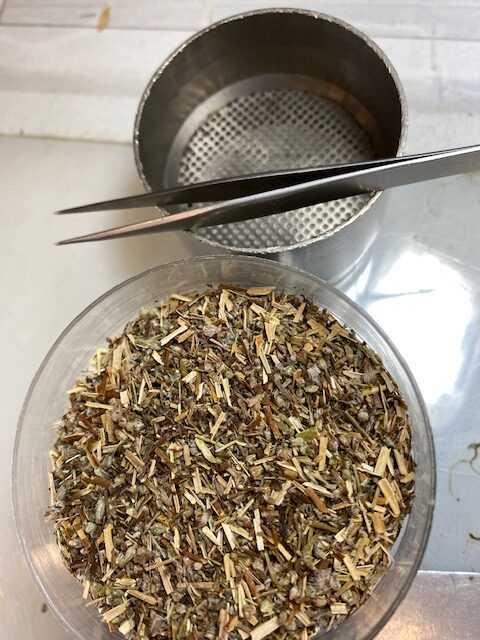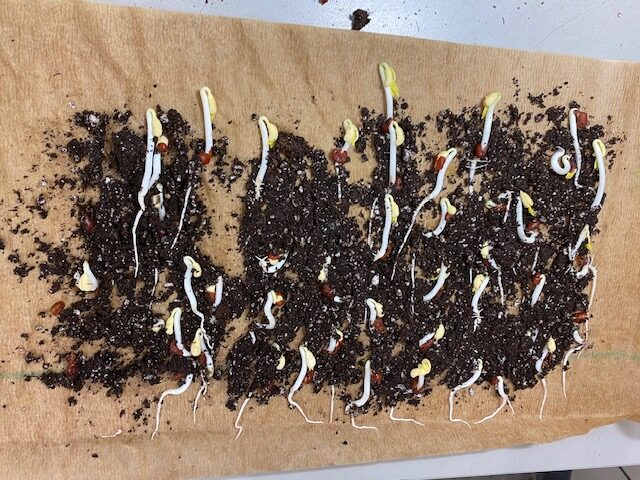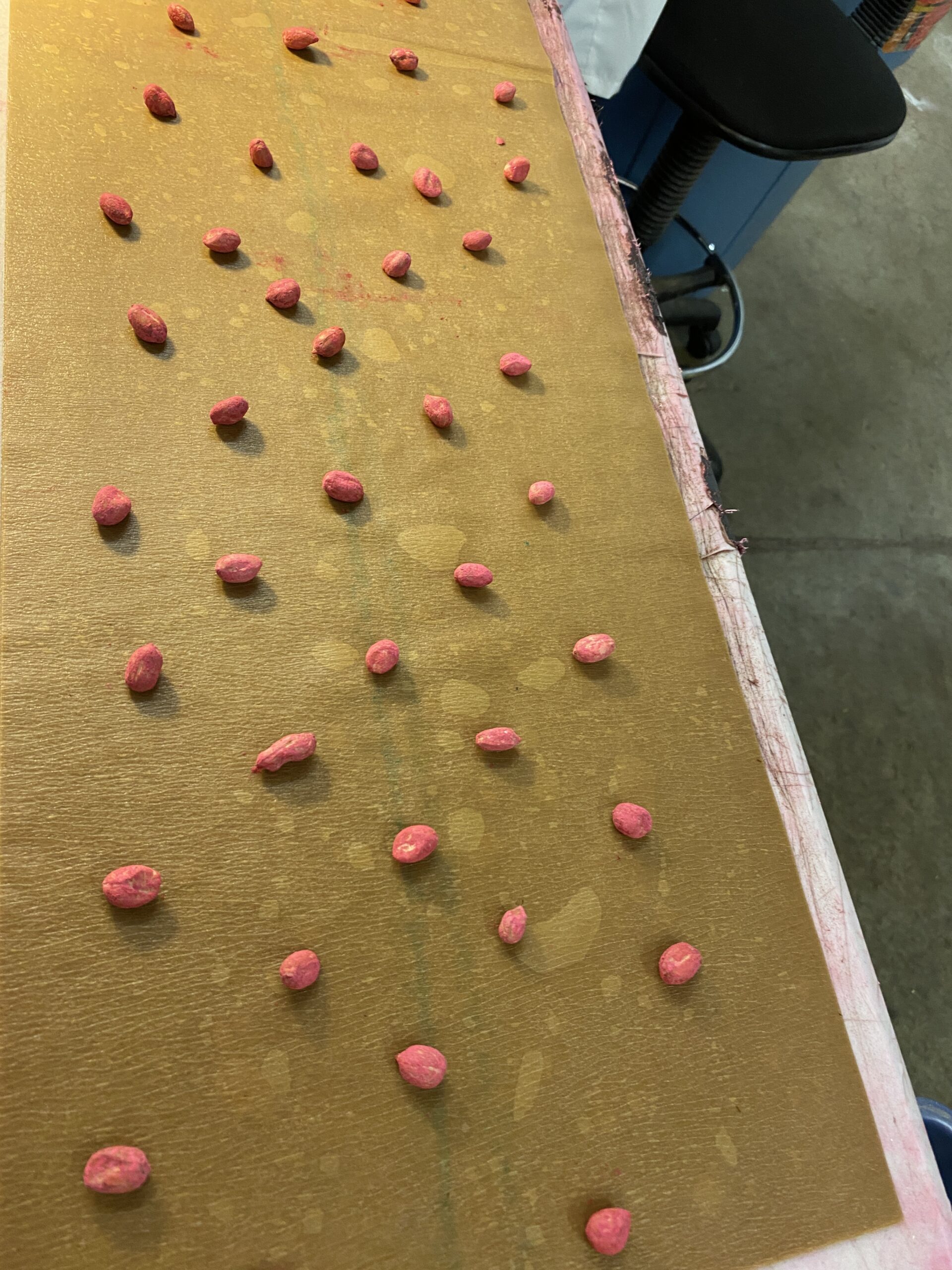
Types of Testing
The AB Seed Laboratory LLC (ABSL) offers a multitude of in-house testing options, including Physical Purity, Germination, Tetrazolium Evaluation, Accelerated Aging, Cold Tests, Texas Cool Tests, Moisture Tests, and a number of other testing options. Along with these testing options the ABSL offers seed counts on Field, Vegetable, Flower, Turf, Herb, and Native Species.
As a member of the Society of Commercial Seed Technologists, the AB Seed Laboratory abides by all AOSA standards when testing. For any inquiries regarding the pricing of our services please contact us at seedtesting@abseedlab.com
Purity and Noxious (P & N)
The purpose of the purity test is to determine what proportion of the sample is crop seed and what proportion is not of the sample crop by dividing the samples into four components, Pure Seed, Inert matter, Other Crop, and Weed Seeds. Upon receiving the sample, the analyst reduces the bulk sample into a smaller sample, or working sample, which will be used for testing.
Once a working sample is determined the Purity Analyst utilizes visual examination, with magnification as required, Specific gravity blowers, and Screens (sieves) to separate the four components of the Purity test. The weights of the four components are then calculated from the weight of the original sample, with greater than five percent of the original sample always used in the working sample to maintain testing integrity.
Usually, the seeds are mixed and then divided into two parts. This process is repeated until a desired amount of seed is reached. To reduce sampling errors, the bulk sample is reduced to the nearest minimum weight as noted in the Rules for Testing Seeds.


Germination (G)
Defined as the resumption of growth by the embryo and development of a young plant from the seed, germination tests are very well known. When both purity and germination tests are required, seeds for the germination test are taken from the pure seed component of the purity analysis, and then planted without discrimination as to size or appearance, regularly 400 seeds are tested for germination with the exception of mixtures. However, when seedling quality is in doubt, commonly 400 more seeds are tested for re-evaluation. When only a germination test is required the pure seed fraction of the sample is estimated to be at least 98% in accordance with section 2.2 of “AOSA Rules for Testing Seeds Vol. 1” During testing, in germination, the percentage of normal seedlings that develop under ideal conditions is recorded. Furthermore, the percentage of hard and dormant seeds is also recorded from the germination test.

Treated Germination (TG)
The purpose of this test is to establish the effectiveness of fungicide seed treatments in controlling seed-borne pathogens on seed lots, as grain seed lots that receive precipitation right before harvesting typically experience disease-related problems in the southern United States.
The treated germination procedure involves hand treating a portion of seed with a fungicide in quantities sufficient to complexly cover the seed coats at an application rate outlined on the fungicide label. A control regular germination test is planted as a paired test and at the conclusion of the germination duration, the two results are recorded for comparison of percent and control of the seed born pathogens.

Grow Out Germination test
The purpose of the ABSL Grow Out Germination test is to replicate field conditions in the lab by growing and evaluating seedlings and plants in optimal controlled environmental conditions. Typically, this test is requested on seed lots with quality issues developed after the normal ASOA germination final count time frame.
The Grow Out Germination test is conducted by planting a known number of seeds in containers with 4-6 inches of soil, and placing the containers into growth chambers calibrated to the optimal environmental conditions required by the particular species to be tested. The seedling is then allowed to develop as far as maturity, removed from the soil substrate, and evaluated in accordance with AOSA Rules for Testing Seed Volume 4. Seedling Evaluation Handbook.
Research and Development
The ABSL has a proud history of conducting R&D in the seed industry. For inquiries regarding R&D please contact us at seedteting@abseedlab.com
Noxious Only (N)
The purpose of a noxious-weed seed examination is to determine the rate of occurrence of the weed seeds considered particularly objectionable or noxious. A certain lot of seed to be tested may contain a certain type of noxious weed seed or only an occasional one. In order to avoid certain errors, it is necessary to use considerably larger samples for noxious-weed tests than for purity determinations. Once the sample is reduced to the proper size, AB Seed analysts always use magnification to make determinations. By using the hand lens, the analysts are able to answer the question regarding the seed’s identity as well as whether the seeds are weed seeds, other crop seeds, or inert matter.
Tetrazolium (TZ)
The two primary uses of this chemical-viability test on seed lots are to establish seed viability quickly and also to determine dormancy at the conclusion of germination testing. In order to conduct this test 2,3,5 Triphenyl Tetrazolium Chloride (TTC) is prepared in concentrations of 0.10 % and 1.0%, the TTC salts are then applied to living tissue, where the TTC salt reduces to formazan as a result of the respiration processes within living tissues release hydrogen, which eventually will combine with the colorless TTC solution in order to produce a red pigment. Because of the TZ test, it is possible to determine the potential viability and vigor ratings within 15 minutes to 24 hours. Strong and healthy tissues develop a normal red stain while aged tissues show a pale or mottled stain. Dead tissues, however, remain white. Therefore, the TZ test can be extremely useful in evaluating dormant seeds at harvest or seeds that require long or uncertain testing periods.
Results of the test are reported to customers in the form of the percentage of viable or dormant seeds observed.
Moisture Test
The moisture content of seeds is an extremely important factor that influences the retention of viability and general appearance of seeds. Knowing the moisture content of seeds is very important in agriculture, and therefore, AB Seed Laboratory takes great pride in offering the moisture test.
The Moisture test can be conducted using either the Oven Method or the Electric Steinlite Moister Balance. The Oven Method uses a convection oven to force dry seeds and determine the moisture content as weight loss due to the removal (evaporation) of water. This procedure involves weighing a quantity of pure seed and placing it in a convection oven at the temperature and duration specified in the “AOSA Seed Moisture Determination Principals and Procedures”. At the conclusion of the drying period, the seed is removed to cool in a desiccation chamber and reweighted for moisture percentage calculations to be made.
The seed can also be tested electronically using the Steinlite Moisture Balance, which requires that a quantity of seed is placed within it, following which it then electronically calculates the moisture content of the seeds.
Texas Cool Test
The Texas Cool test is a test used to determine the relative vigor of cotton seeds. This test is conducted at 64 degrees Fahrenheit, with seedlings being counted after 7 days, in a comparison of the normal germination test.
Saturated Cold Test
The purpose of the Saturated Cold Test is to determine the relative effect of cold moist environmental conditions on seed emergence and germination. The Saturated Cold test is commonly requested for Corn, Soybean, and Peanut samples, but modifications for other crops can be made based on the “Seed Vigor Testing Handbook”, contribution No.32 to the Handbook on Seed testing, November 2009 Edition.
For this test samples are planted on germination towels, covered with soil wet to a saturated condition, and then rolled up and secured with rubber bands. Towels are then placed in a pre-chill germinator held at 7 degrees Celsius for seven days. Following this seven-day period, the towels are then transferred to a standard germinator held between 20-30 degrees Celsius depending on the species, where the germination results are then compared to the sample’s non-stressed germination.
Seed Count
The purpose of the Seed Count is to accurately determine the number of pure seeds per pound or kilogram for labeling purposes. When conducting seed counts only pure seed is used, as pure seeds are counted out by hand or with a germination counter, counting 100 of each seed at random. Following this our technicians then weigh each replicate in grams to find significant figures. Finally, the number of seeds per gram is calculated using the following formula:
Number of seeds per gram = ((400)/(Mean weight (g) of 400 seed units))
Pennsylvania Undesirable Grass Test
The Pennsylvania Undesirable Grass Test is a purity examination in which specific undesirable seeds are listed by name and number per pound when present in samples of Bentgrass, Kentucky Bluegrass, Chewings Fescue, Hard Fescue, Red Fescue, varieties named Turf Type Tall Fescue, varieties of Perennial Ryegrass or mixtures containing these grasses.
Composite Germination Test
A composite germination test is a germination test conducted on seed mixtures (typically flower seed mixtures).
Composite germination is a cost and time-saving method of testing germination potential without separating each component of a mixture and testing them individually. It should be noted that a composite germination test is a non-AOSA procedure and will be reflected as such on the report.
Vigor Test / Accelerated Aging (VT)
The purpose of this test is to determine a seed lot’s relative vigor (seed health/storability) by exposing the seed lot to extremely stressful environmental conditions (100 degrees Fahrenheit and 100% Relative Humidity) for three days prior to germination. This is done in direct comparison to a germination test on the same seed lot where optimal conditions are provided. The seeds used to conduct a Vigor Test are obtained from the Pure Seed portion of the Purity Test and are then placed in a container containing 50ml of water, with no contact between the seeds and the water. The results of this test can help determine the viability of seeds under potentially hazardous environmental conditions.
The Vigor Testing procedures for individual species are obtained from the “Seed Vigor Testing Handbook”, contribution No.32 to the Handbook on Seed testing, November 2009 Edition.
Cool Germination Test
The purpose of the Cool germination Test is to determine the relative vigor of cotton seed after exposure to cool germination conditions. During this test, four replicates of 50 cotton seeds are placed on saturated towels, rolled up, and placed upright in a germinator set at 18 degrees Celsius for seven days without lighting. At the end of this seven-day germination, period seedlings are evaluated, with seedlings having a combined hypocotyl and root length of 4cm or longer considered high vigor.
Along with standard germination tests, the Cool Test is recommended to test growing conditions similar to the unfavorable conditions which may prevail in the field later during planting. This test is meant to detect weaknesses and measure the seeds’ response to unfavorable conditions. This test is usually compared with a standard germination test to accurately portray results.